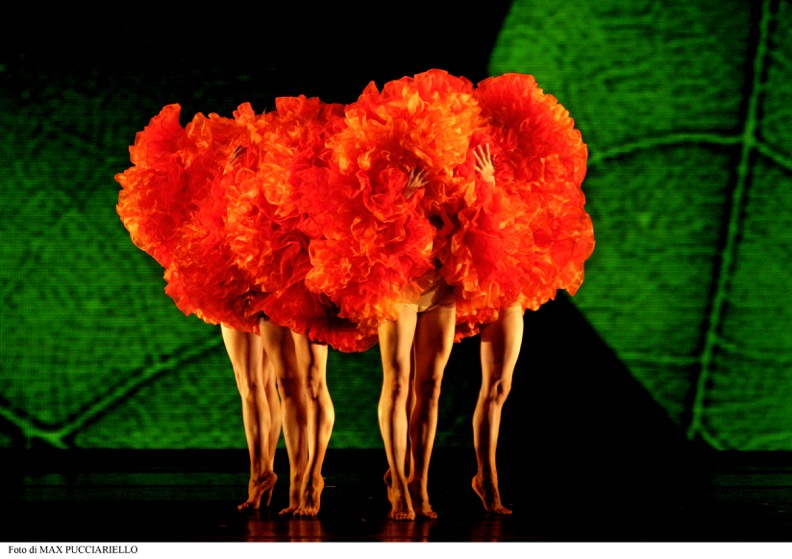On an autumn afternoon in a rehearsal hall located along a wooded country road in Washington, Connecticut, six MOMIX performers find themselves in a wonderland.
As music begins, they move rhythmically, bouncing giant, cobalt blue rubber balls in Oompa Loompa unison. As the melody becomes more sharply metered, they toss the shiny spheres to each other with clockwork precision. Then, they glide over the giant orbs on their stomachs, as if they were bodysurfing speed bumps, before regrouping and collectively transforming themselves as one long, undulating…could it be?…caterpillar.
Or maybe not.
Things could change in the development of this work in progress, says Moses Pendleton, whose dance illusion company has transfixed audiences internationally for nearly four decades.
The dancers, Pendleton and Cynthia Quinn (his longtime life partner and former MOMIX dancer), are collaborating on a new piece, the first for the company in several years. “ALICE” is an evening-length work inspired by Lewis Carroll’s “Alice in Wonderland” and “Alice Through the Looking Glass.” It will receive a soft opening January 12 and 13 at the Warner Theatre in Torrington, before its official world premiere in Italy in February. The company will also perform a “Best of MOMIX” program at the Jorgensen Center for the Performing Arts at UConn at Storrs on February 6, with a Q&A session immediately following the performance.
“You never know what Moses is going to do,” says dancer Gregory DeArmond, who has been with the company for four years. “When he gets in the studio he has an idea and a vision, but he’s not stuck to it and it’s all a collaborative process. We’re still playing with things in the studio but he’ll be changing things up until the premiere – and even when the production is touring, it will continue to transform.”
 IT’S A NATURAL
IT’S A NATURAL
For MOMIX fans, Alice’s adventures are a natural subject for the company.
“It goes back to Pilobolus and MOMIX,” says Pendleton, who formed MOMIX in 1981 as an offshoot of his first dance company, Pilobolus, which he co-founded in his senior year of Dartmouth College. Pilobolus also continues to create new pieces just down the road from MOMIX in Washington Depot, albeit not with any of its original founders remaining as artistic directors.
Both Pilobolus (named after a mushroom known for its explosive spores) and MOMIX (named for a dairy supplement fed to veal calves) explore dance in terms of sculptural forms, both sensual and surreal.
MOMIX describes itself as presenting “illusionist choreography,” creating pieces that confuse, intrigue, seduce and delight the eye by utilizing a wide variety of forms and techniques — acrobatics, gymnastics, dance, yoga, mime, props, costumes, lighting and projections — into a singular moving experience.
“MOMIX implies a certain kind of controlled nonsense and visual poetry with amazing bodies doing amazing things,” says Pendleton. “It’s a highly physical and visual theater. We use props and imagery and nature and take the human body to make connections to the non-human. MOMIX is also about escaping the so-called ‘real world’ to experience the surreal.”
Over the years, he says, both companies have often been described in “Alice” metaphors: “Talking about our illusions, how we changed the scale of things, the dreams, the nonsense, the surreal.”
Pendleton says he never intended – or intends – to do a literal interpretation of Carroll’s ripe-for-interpretation evergreen. But a photographic gig last year using the dancers for an “Alice”-themed calendar launched Pendleton down his rabbit hole of “Alice” research.
That’s when this new MOMIX piece began to happen in earnest.
But there was a practical reason, too.
“MOMIX is a mom-and-pop operation,” says Pendleton, who turns 70 in March and runs the company with Quinn. “The reason for doing this is as simple and as boring as this: We just have to make a new show to run another three-year cycle, and I said I’d give it one more shot.”

INSPIRATIONAL LITCHFIELD HILLS
Pendleton has always found a free-flowing stream – of consciousness, of creativity, of water – amid his natural surroundings among the Litchfield Hills, which Pendleton has called home since the ‘70s. He first arrived during the early days of Pilobolus because co-artistic director Martha Clarke lived in the area and the company found the natural beauty of the area to be inspirational for their works.
In the late ‘70s, a realtor showed Pendleton a barn on Bell Hill Road that could be used as a rehearsal studio. He also showed him the house across the street that was for sale. Whether it was the smell of spring air, the angle of the light or the funkiness of the digs, it was love at first sight.
Pendleton bought the barn, the eight acre-property and the 22-room, homey/haunting Victorian house surrounded by hawthorn trees, which is said to ward off evil spirits. The three-story fun house, with its towering, invasion ready turret and a wrap-around porch, offers panoramic views of the countryside.
WHO’S IN, WHO’S OUT
The process of MOMIX-ing Carroll’s “Alice” was one that emerged over several Connecticut seasons in the rehearsal hall.“You don’t copy Lewis Carroll but reference him,” says Pendleton, who points out how other artists, from Salvador Dali to Tim Burton, have used Carroll’s
work as inspiration for their own visions.
Tweedledum and Tweedledee, the Cheshire Cat, Humpty Dumpty, and the Mad Hatter are all characters rich for the MOMIX treatment.
But what about Alice?
“I’m willing to give Alice a shot,” says Pendleton. “She’s auditioning for the show and so are the others but we haven’t decided anything yet for sure — even the Caterpillar, who just might come out at the beginning of the show and say, ‘You know I’ve never been given enough credit – so put that in your pipe and smoke it.’ ”
Pendleton says he is also toying with the idea of doing a voice-over as Lewis Carroll. After all, the two men have a shared passion for photography and playful language.

TITLE TRAUMA
Then there’s the title.
“I have a sister Alice so maybe we should just call the piece ‘Alice Pendleton’ or maybe ‘MOMIX in Wonderland’ or ‘Shades of Alice.’ I’ve thought of that title today. Or ‘A.I. Wonderland’ where Alice is a robot, and Wonderland is run by Google. I also like ‘Muscaria,’ which is the mushroom that Alice ate to make her grow tall or small. It’s a psychoactive drug that makes you go to these places that she would experience under the influence. That’s a world I’m somewhat familiar with.”
On Pendleton’s mind of late is Michael Pollan’s book, How to Change Your Mind: What the New Science of Psychedelics Teaches Us About Consciousness, Dying, Addiction, Depression, and Transcendence.
“[In reading the book], I started seeing all the relevancy of tweaking the brain into a world of dreams, surrealism and other possibilities. It doesn’t mean you’re ill or you’re trying to escape, but maybe you’re trying to develop a new reality that may be part of our health, education and welfare. After all, Alice is just a figment, a pigment, a smattering of Carroll’s imagination. Just because there’s a 100-year-plus difference in our times doesn’t mean that you can’t reconnect, and transcend time and space. There’s an energy there – and a kind of belief that that’s possible.”
For more information on the dance company and its productions, visit momix.com.
Frank Rizzo is a theater critic for Variety and arts writer covering Connecticut for the last 40 years, writing for a variety of in-state publications as well as for The New York Times and American Theatre magazine. His blog is ShowRiz.com and you can follow him on ShowRiz@Twitter. He lives in New Haven.






More Stories
A New, Free Peabody Museum Prepares for Opening
Arts & Entertainment – Autumn ’23
Richard Thomas: Acting Is His Life